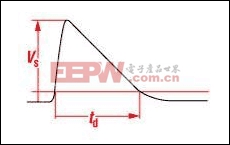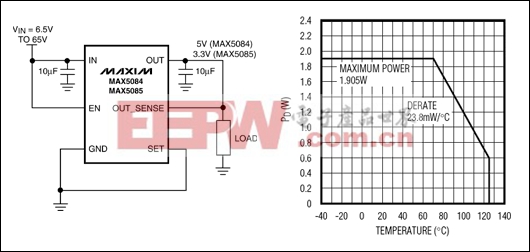Automotive Linear Regulators M
functions in a modern car draw battery current continuously: anti-theft protection, alarm system, keyless entry receiver, and tire-pressure measurement system, to name a few. Moreover, certain nodes on the CAN bus are constantly "listening" to the bus so they can wake up immediately when their support is needed.
Depending on the manufacturers and on the total number of such nodes, all these separate small quiescent currents can sum to several milliamps, or perhaps as much as 100mA of continuous current from the battery. Now, consider again the car at the airport: cold weather, city traffic, and age had possibly already reduced the available capacity to the half its nominal value. Thus the battery had only 25Ah left when the car was parked. Given a continuous quiescent current of only 25mA, the capacity lost over 21 days is 12.6Ah. As that amount is removed from the battery just while it is parked, the remainder of battery capacity is reduced to a quarter of the original value. The resulting capacity might not be enough to start a cold motor!
Caution: High Voltage
As a response to the problem of reduced, or exhausted batter capacity, car electronics systems—even those without an always-on or standby mode—constantly need power-supply options that minimize their quiescent current. Small linear regulators made with CMOS seem to be a good idea, because some such devices draw very little quiescent current indeed. The MAX1725, for instance, draws a mere 2μA. Unfortunately, however, the power supply must also have a wide input-voltage range to handle the so-called load-dump pulse, which is a brief but severe overvoltage caused by disconnecting the battery while the alternator is running.
Because the alternator's control loop is not fast enough to close, it generates a high output-voltage pulse when the battery voltage is removed. This high-energy pulse is normally clamped to a lower voltage at some central location in the car, but car manufacturers also specify to their suppliers the remaining overvoltage to be expected at the inputs of their power supplies. This spec differs among car manufacturers, but the typical peak value is 36V in cars and 58V in trucks. Some values are even higher. The duration of a typical load-dump pulse is several tenths of a second (Figure 1).
Figure 1. This typical load-dump overvoltage pulse reaches a maximum amplitude (Vs) of 36V in cars and 58V in trucks. Its duration (td) is several hundred milliseconds.
Power Dissipation and Temperature
These high input-voltage levels lead us directly to the next point to consider. The linear regulator not only must withstand the overvoltage specified, it must also dissipate considerable power when delivering a high load current at low output voltage. Converting a car's typical 13V input to 5V with a 50mA load might not be critical—that is only 400mW of dissipation and just within the maximum rating for a standard SO8 package. During the overvoltage condition described above, however, the power-dissipation level at 36V increases to more than 1.5W.
All packages derate their power-dissipation capability with increasing temperature, so that amount of dissipation could become a problem at higher temperatures. A regulator IC in a regular SO8 package would quickly go into thermal shutdown. The regulator would survive and resume operation after it cooled down, but that does not help because we need to keep the function alive. Automotive linear regulators need advanced packages capable of high power dissipation.
A standard automotive linear regulator like the MAX5084 is designed to operate over the automotive temperature range. It has a 65V input range, 50μA typical quiescent current, and a guaranteed output current of 200mA. Its 6-pin TDFN package with exposed pad is capable of 1.9W continuous power dissipation at +70°C, but (as for all packages) that capability is derated at higher temperatures (Figure 2). At +125°C, this package is still capable of dissipating more power than does the standard SO8 package at room temperature. Additional device features include a Kelvin-sense option that controls the output voltage directly at the load, a SET pin that programs output voltages other than the standard 3.3V and 5V, and an Enable function. If the standby function is not needed, you can disable the device which lowers the typical supply current to 6μA.
Figure 2. This small but powerful automotive linear regulator comes in a 6-pin TDFN package, and can dissipate up to 1.9W. At the maximum-allowed ambient temperature (+125°C) it can dissipate 600mW.
模拟电路 模拟芯片 德州仪器 放大器 ADI 模拟电子 相关文章:
- 12位串行A/D转换器MAX187的应用(10-06)
- AGC中频放大器设计(下)(10-07)
- 低功耗、3V工作电压、精度0.05% 的A/D变换器(10-09)
- PIC16C5X单片机睡眠状态的键唤醒方法(11-16)
- 用简化方法对高可用性系统中的电源进行数字化管理(10-02)
- 利用GM6801实现智能快速充电器设计(11-20)
